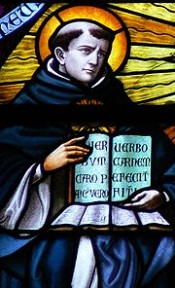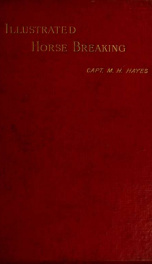Thomas Aquinas Saint

Saint Thomas Aquinas, O.P. (also Thomas of Aquin or Aquino; born ca. 1225; died 7 March 1274) was an Italian priest of the Roman Catholic Church in the Dominican Order, and an immensely influential philosopher and theologian in the tradition of scholasticism, known as Doctor Angelicus and Doctor Communis. He is frequently referred to as Thomas because "Aquinas" refers to his residence rather than his surname. He was the foremost classical proponent of natural theology, and the father of the Thomistic school of philosophy and theology. His influence on Western thought is considerable, and much of modern philosophy was conceived as a reaction against, or as an agreement with, his ideas, particularly in the areas of ethics, natural law and political theory. Aquinas is held in the Catholic Church to be the model teacher for those studying for the priesthood.[1] The works for which he is best-known are the Summa Theologica and the Summa Contra Gentiles. One of the 33 Doctors of the Church, he is considered by many Catholics to be the Church's greatest theologian and philosopher. Aquinas was born c. 1225 out of his father Count Landulf of Aquino's castle of Roccasecca in the Kingdom of Sicily, in the present-day Lazio. Through his mother, Theodora Countess of Theate, Aquinas was related to the Hohenstaufen dynasty of Holy Roman emperors.[2] Landulf's brother Sinibald was abbot of the original Benedictine abbey at Monte Cassino. While the rest of the Aquinas sons pursued a military career,[3] the family intended for Aquinas to follow his uncle into the abbacy;[4] this would have been a normal career path for a younger son of southern Italian nobility.[2] At the age of five, Aquinas began his early education at Monte Cassino but after the military conflict that broke out between the Emperor Frederick II and Pope Gregory IX spilled into the abbey in early 1239, Landulf and Theodora had Aquinas enrolled at the studium generale (university) recently established by Frederick in Naples.[5] It was here that Aquinas was probably introduced to Aristotle, Averroes and Maimonides, all of whom would influence his theological philosophy.[6] It was also during his study at Naples that Aquinas came under the influence of John of St. Julian, a Dominican preacher in Naples, who was part of the active effort by the Dominican order to recruit devout followers.[7] Here his teacher in arithmetic, geometry, astronomy, and music was Petrus de Ibernia.[8] At age nineteen, Thomas resolved to join the Dominican Order. Aquinas' change of heart did not please his family, who had expected him to become a Benedictine monk.[9] In an attempt to prevent Theodora's interference in Aquinas' choice, the Dominicans arranged for Aquinas to be removed to Rome, and from Rome, sent to Paris.[10] On his way to Rome, his brothers, per Theodora's instructions, seized him as he was drinking from a spring and took him back to his parents at the castle of Monte San Giovanni Campano.[10] He was held for two years in the family homes at Monte San Giovanni and Roccasecca in an attempt to prevent him from assuming the Dominican habit and to push him into renouncing his new aspiration.[6] Political concerns prevented the Pope from ordering Aquinas' release, extending the detention,[11] a detention which Aquinas spent tutoring his sisters and communicating with members of the Dominican Order.[6] Family members became desperate to dissuade Aquinas, who remained determined to join the Dominicans. At one point, two of his brothers hired a prostitute to seduce him, but he drove her away, wielding a burning stick. According to legend, that night two angels appeared to him as he slept and strengthened his determination to remain celibate.[12] By 1244, seeing that all of her attempts to dissuade Aquinas had failed, Theodora sought to save face, arranging for Aquinas to escape at night through his window. In her mind, a secret escape from detention was less damaging than an open surrender to the Dominicans. Aquinas was sent first to Naples and then to Rome to meet Johannes von Wildeshausen, the Master General of the Dominican Order.[13] In 1245, Aquinas was sent to study at the University of Paris' Faculty of Arts where he most likely met Dominican scholar Albertus Magnus[14], then the Chair of Theology at the College of St. James in Paris.[15] When Albertus was sent by his superiors to teach at the new studium generale at Cologne in 1248,[14] Aquinas followed him, declining Pope Innocent IV's offer to appoint him abbot of Monte Cassino as a Dominican.[4] Albertus then appointed the reluctant Aquinas magister studentium.[2] After failing in his first theological disputation, Albertus prophetically exclaimed: "We call him the dumb ox, but in his teaching he will one day produce such a bellowing that it will be heard throughout the world."[4] Aquinas taught in Cologne as an apprentice professor (baccalaureus biblicus), instructing students on the books of the Old Testament and writing Expositio super Isaiam ad litteram (Literal Commentary on Isaiah), Postilla super Ieremiam (Commentary on Jeremiah) and Postilla super Threnos (Commentary on Lamentations).[16] Then in 1252 he returned to Paris to study for the master's degree in theology. He lectured on the Bible as an apprentice professor, and upon becoming a baccalaureus Sententiarum (bachelor of the Sentences)[17] devoted his final three years of study to commenting on Peter Lombard's Sentences. In the first of his four theological syntheses, Aquinas composed a massive commentary on the Sentences entitled Scriptum super libros Sententiarium (Commentary on the Sentences). Aside from his masters writings, he wrote De ente et essentia (On Being and Essence) for his fellow Dominicans in Paris.[4] In spring of 1256, Aquinas was appointed regent master in theology at Paris and one of his first works upon assuming this office was Contra impugnantes Dei cultum et religionem (Against Those Who Assail the Worship of God and Religion), defending the mendicant orders which had come under attack by William of Saint-Amour.[18] During his tenure from 1256 to 1259, Aquinas wrote numerous works, including: Questiones disputatae de veritate (Disputed Questions on Truth), a collection of twenty-nine disputed questions on aspects of faith and the human condition [19] prepared for the public university debates he presided over on Lent and Advent;[20] Quaestiones quodlibetales (Quodlibetal Questions), a collection of his responses to questions posed to him by the academic audience;[19] and both Expositio super librum Boethii De trinitate (Commentary on Boethius's De trinitate) and Expositio super librum Boethii De hebdomadibus (Commentary on Boethius's De hebdomadibus), commentaries on the works of 6th century philosopher Anicius Manlius Severinus Boethius.[21] By the end of his regency, Aquinas was working on one of his most famous works, Summa contra Gentiles.[22] Around 1259, Aquinas returned to Naples where he lived until he arrived in Orvieto around September 1261. In Orvieto, he was appointed conventual lector, in charge of the education of friars unable to attend a studium generale. During his stay in Orvieto, Aquinas completed his Summa contra Gentiles, and wrote the Catena Aurea (The Golden Chain).[23] He also wrote the liturgy for the newly created feast of Corpus Christi and produced works for Pope Urban IV concerning Greek Orthodox theology, e.g. Contra errores graecorum.[22] In 1265 he was ordered by the Dominicans to establish a studium for the Order in Rome at the priory of Santa Sabina, which he did from 1265 until he was called back to Paris in 1268.[24] It was in Rome that Aquinas began his most famous work, Summa Theologica,[23] and wrote a variety of other works like his unfinished Compendium Theologiae and Responsio ad fr. Ioannem Vercellensem de articulis 108 sumptis ex opere Petri de Tarentasia (Reply to Brother John of Vercelli Regarding 108 Articles Drawn from the Work of Peter of Tarentaise).[21] In his position as head of the studium, conducted a series of important disputations on the power of God, which he compiled into his De potentia.[24] In 1268 the Dominican Order assigned Aquinas to be regent master at the University of Paris for a second time, a position he held until the spring of 1272. Part of the reason for this sudden reassignment appears to have arisen from the rise of "Averroism" or "radical Aristotelianism" in the universities. In response to these perceived evils, Aquinas wrote two works, one of them being De unitate intellectus, contra Averroistas (On the Unicity of Intellect, against the Averroists) in which he blasts Averroism as incompatible with Christian doctrine.[25] During his second regency, he finished the second part of the Summa and wrote De virtutibus and De aeternitati mundi,[24] the latter of which dealt with controversial Averroist and Aristotelian beginninglessness of the universe.[26] Disputes with some important Franciscans such as Bonaventure and John Peckham conspired to make his second regency much more difficult and troubled than the first. A year before Aquinas re-assumed the regency at the 1266-67 Paris disputations, Franciscan master William of Baglione accused Aquinas of encouraging Averroists, calling him the "blind leader of the blind". Aquinas called these individuals the murmurantes (Grumblers).[26] In reality, Aquinas was deeply disturbed by the spread of Averroism and was angered when he discovered Siger of Brabant teaching Averroistic interpretations of Aristotle to Parisian students.[27] On 10 December 1270, the bishop of Paris, Etienne Tempier, issued an edict condemning thirteen Aristotlelian and Averroistic propositions as heretical and excommunicating anyone who continued to support them.[28] Many in the ecclesiastical community, the so-called Augustinians, were fearful that this introduction of Aristotelianism and the more extreme Averroism might somehow contaminate the purity of the Christian faith. In what appears to be an attempt to counteract the growing fear of Aristotelian thought, Aquinas conducted a series of disputations between 1270 and 1272: De virtutibus in communi (On Virtues in General), De virtutibus cardinalibus (On Cardinal Virtues) De spe (On Hope).[29]
do you like this author?
What readers are saying
What do you think? Write your own comment on this book!
write a commentWhat readers are saying
What do you think? Write your own comment on this author!
write a commentBook list

On Prayer and The Contemplative Life
Series:
Unknown
Year:
Unknown
Raiting:
1/5
A work by Saint Thomas Aquinas, an Italian priest of the Catholic Church in the Dominican Order, and an immensely influential philosopher and theologian in the tradition of scholasticism. The book deals with the questions of the virtue of religion, devotion, prayers, active and contemplative life, and the religious state.
Show more
add to favoritesadd In favorites

Summa Theologica, Part I (Prima Pars)
Series:
Unknown
Year:
Unknown
Raiting:
1/5
One of the most famous philosophical writings in history, and major work by an Italian priest of the Catholic Church in the Dominican Order, and an immensely influential philosopher and theologian in the tradition of scholasticism, Saint Thomas Aquinas. In “Summa Theologica” the author tried to systematize the results of his work, to present them in brief and accessible form, first of all for students. The book consists of three parts - pars prima, pars prima secundae and pars secunda secundae, pars tertia. This volume comprises questions concerning the nature and attributes of God, the second includes articles devoted to the act of Creation and angels, and the third deals with a man and Providence. A disputable issue is set in the title of the article, then several arguments, giving contradictory answers, follow, along with the solution and answers to the arguments. Each chapter is connected to the previous and others with the general system of argumentation and provided with inner references. The treatise was not finished by Thomas Aquinas, due to his ecstatic vision, after which he stopped writing.
Show more
add to favoritesadd In favorites

Summa Theologica, Part III (Tertia Pars)
Series:
Unknown
Year:
Unknown
Raiting:
1/5
This book is a real masterpiece that belongs to the pen of Saint Thomas Aquinas (1225–1274). It contains the most prominent thoughts on the topical of theology of that time. The author does a fantastic job in describing the western theology in terms of Christianity which is based on the Roman Catholic church. Summa Theologica, Part III covers such topics as God and its relationship with Man, and the place of Man in this world. Saint Thomas Aquinas introduces in this book his five famous arguments supporting the existence of God. Summa Theologica quotes the books of Augustine of Hippo, Aristotle, and other scholars.
Show more
add to favoritesadd In favorites
Book list

On Prayer and The Contemplative Life
Series:
Unknown
Year:
Unknown
Raiting:
1/5
A work by Saint Thomas Aquinas, an Italian priest of the Catholic Church in the Dominican Order, and an immensely influential philosopher and theologian in the tradition of scholasticism. The book deals with the questions of the virtue of religion, devotion, prayers, active and contemplative life, and the religious state.
Show more
add to favoritesadd In favorites

Summa Theologica, Part I (Prima Pars)
Series:
Unknown
Year:
Unknown
Raiting:
1/5
One of the most famous philosophical writings in history, and major work by an Italian priest of the Catholic Church in the Dominican Order, and an immensely influential philosopher and theologian in the tradition of scholasticism, Saint Thomas Aquinas. In “Summa Theologica” the author tried to systematize the results of his work, to present them in brief and accessible form, first of all for students. The book consists of three parts - pars prima, pars prima secundae and pars secunda secundae, pars tertia. This volume comprises questions concerning the nature and attributes of God, the second includes articles devoted to the act of Creation and angels, and the third deals with a man and Providence. A disputable issue is set in the title of the article, then several arguments, giving contradictory answers, follow, along with the solution and answers to the arguments. Each chapter is connected to the previous and others with the general system of argumentation and provided with inner references. The treatise was not finished by Thomas Aquinas, due to his ecstatic vision, after which he stopped writing.
Show more
add to favoritesadd In favorites

Summa Theologica, Part III (Tertia Pars)
Series:
Unknown
Year:
Unknown
Raiting:
1/5
This book is a real masterpiece that belongs to the pen of Saint Thomas Aquinas (1225–1274). It contains the most prominent thoughts on the topical of theology of that time. The author does a fantastic job in describing the western theology in terms of Christianity which is based on the Roman Catholic church. Summa Theologica, Part III covers such topics as God and its relationship with Man, and the place of Man in this world. Saint Thomas Aquinas introduces in this book his five famous arguments supporting the existence of God. Summa Theologica quotes the books of Augustine of Hippo, Aristotle, and other scholars.
Show more
add to favoritesadd In favorites

Summa Theologica, Part I-II (Pars Prima Secundae)
Series:
Unknown
Year:
Unknown
Raiting:
1.5/5
This book is a real masterpiece that belongs to the pen of Saint Thomas Aquinas (1225–1274). It contains the most prominent thoughts on the topical of theology of that time. The author does a fantastic job in describing the western theology in terms of Christianity which is based on the Roman Catholic church. Summa Theologica, Part I-II covers such topics as God and its relationship with Man, the purpose of Man, God's creation, Christ. Saint Thomas Aquinas introduces in this book his five famous arguments supporting the existence of God. Summa Theologica quotes the books of Augustine of Hippo, Aristotle, and other scholars.
Show more
add to favoritesadd In favorites

Summa Theologica, Part II-II (Secunda Secundae)
Series:
Unknown
Year:
Unknown
Raiting:
4/5
This book was converted from its physical edition to the digital format by a community of volunteers. You may find it for free on the web. Purchase of the Kindle edition includes wireless delivery.
Show more
add to favoritesadd In favorites
What readers are saying
What do you think? Write your own comment on this author!
write a commentif you like Thomas Aquinas Saint try:
readers also enjoyed
What readers are saying
What do you think? Write your own comment on this author!
write a commentGenre
if you like Thomas Aquinas Saint try:
readers also enjoyed
Do you want to exchange books? It’s EASY!
Get registered and find other users who want to give their favourite books to good hands!





















